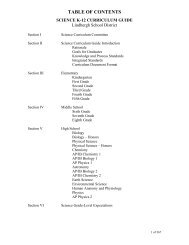test-taking tips you can use with your family. - Lindbergh School ...
test-taking tips you can use with your family. - Lindbergh School ...
test-taking tips you can use with your family. - Lindbergh School ...
Create successful ePaper yourself
Turn your PDF publications into a flip-book with our unique Google optimized e-Paper software.
Ten Tips for Improving Your Child’s Performance on the<br />
MAP Communication Arts Test<br />
The MAP <strong>test</strong> provides data to teachers to help improve instruction and target areas of need for <strong>you</strong>r child(ren). For<br />
that reason, it’s important that <strong>you</strong>r child(ren)’s <strong>test</strong> scores accurately depict their learning. Most of the <strong>tips</strong> found<br />
here are applicable to a variety of grades and may be adjusted to better fit individual situations.<br />
The following is an adaptation from Navigating the MAP: Communication Arts, a publication of the Missouri<br />
Department of Elementary and Secondary Education’s Curriculum Section. The 10 following <strong>tips</strong> were originally<br />
written to aid teachers. We’ve altered the language to accommodate parents. We hope <strong>you</strong> will find the information<br />
and suggestions in these ten <strong>tips</strong> <strong>use</strong>ful as <strong>you</strong> work <strong>with</strong> <strong>you</strong>r children.<br />
Tip #1: Read, read, read!<br />
One of the most surprising findings of research is how little reading students are actually doing. Reading, like any<br />
other skill, takes practice. Students don’t practice reading by doing worksheets; they practice reading by reading.<br />
Therefore, one of the best and simplest steps to improve the reading ability of children is to provide sustained<br />
periods of time for children to read.<br />
Tip #2: Help <strong>you</strong>r child to read like a writer.<br />
One of the best ways to improve reading comprehension is to teach children to read from the point of view of the<br />
writer. Even in the early grades, students <strong>can</strong> begin to “get into the head” of the author. Thinking like a writer<br />
improves both the reading and writing ability of children.<br />
Tip #3: Read a variety of books and magazines.<br />
In the world outside of school, students need to be able to read a wide variety of texts, from road signs to restaurant<br />
menus, from comic books to classics, from tennis shoe ads to computer manuals. The MAP Communication Arts<br />
<strong>test</strong> contains short stories, poems, dialogues, magazines articles, charts and tables. To help <strong>you</strong>r child become savvy<br />
in many reading situations, provide him <strong>with</strong> abundant and diverse reading opportunities.<br />
Tip #4: Build <strong>you</strong>r child’s reading stamina.<br />
One of the main problems children face <strong>with</strong> reading, specifically reading multiple passages on a <strong>test</strong>, is they just<br />
give up. Reading <strong>test</strong>s usually employ a collection of passages of varying difficulty. Some of the passages will be<br />
below grade level; and still others will be above grade level. So the advice to “do the best <strong>you</strong> <strong>can</strong>” is probably<br />
appropriate.<br />
You may also help <strong>you</strong>r child by:<br />
• Creating voices for the characters in books and then re-read the passages using these voices <strong>with</strong><br />
exaggerated expression.<br />
• Re-reading passages aloud.<br />
• Keeping foc<strong>use</strong>d on the text by following along <strong>with</strong> a finger under the words.<br />
To build reading stamina, <strong>you</strong> may want to encourage <strong>you</strong>r child to:<br />
• Gradually increase the amount of time he or she reads at one sitting.<br />
• Set individual reading goals.<br />
• Take short breaks, such as stretching or closing their eyes for a minute.








